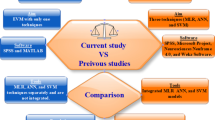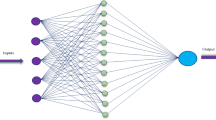Abstract
The study addresses the significant challenge of rework in the construction industry by leveraging machine learning techniques. Specifically, the aim is to develop models that accurately classify the impact of rework causes on the cost performance of bridge projects using objective data sources. Pertinent rework sources and determinants were identified, and a multivariate dataset of prior projects’ cost performance was assembled. Additionally, a structural equation model was developed to calculate the impact of these factors on cost performance in bridge projects. To create a suitable dataset for machine learning, 272 responses from subject matter experts were utilized. The study explores Ensemble techniques, K-Nearest Neighbors (KNN), Artificial Neural Networks (ANN), and Support Vector Machines (SVM). Cross-validation tests were conducted to assess the predictive abilities of the models, and the evaluation results indicated that the SVM model provides superior predictive performance for the dataset examined. SVM achieves 98.53% (89.54%) accuracy in training (testing) with a 1.47% (10.46%) misclassification error. Comparisons were made regarding the impact of rework on cost, with SVM achieving the highest recognition rate across all data divisions, followed by ANN. Conversely, KNN exhibited the lowest recognition rate among the classifiers. With a maximum recognition rate of 97%, SVM emerged as the best classifier. The optimal data separation for testing and training data was determined to be 10% and 90%, respectively. Overall, this study harnesses the power of machine learning to facilitate evidence-based decision-making, enabling proactive prediction of the impact of rework on cost performance in bridge projects.




Similar content being viewed by others
Data availability
No datasets were generated or analysed during the current study.
References
Abeku, D. M., Ogunbode, E. B., Salihu, C., Maxwell, S. S., & Kure, M. A. (2016). Projects management and the effect of rework on construction works: A case of selected projects in Abuja Metropolis, Nigeria. International Journal of Finance and Management in Practice, 4(1), 329–349.
Al-Janabi, A. M., Abdel-Monem, M. S., & El-Dash, K. M. (2020). Factors causing rework and their impact on projects’ performance in Egypt. Journal of Civil Engineering and Management. https://doi.org/10.3846/jcem.2020.12916
Alla, V., Sahoo, U. K., & Behera, R. N. (2023). Seismic liquefaction analysis of MCDM weighted SPT data using support vector machine classification. Iranian Journal of Science and Technology, Transactions of Civil Engineering. https://doi.org/10.1007/s40996-023-01293-6
Arbuckle, J. L. (2011). IBM SPSS Amos 20 user’s guide (pp. 226–229). Amos Development Corporation.
Badawy, M., Hussein, A., Elseufy, S. M., & Alnaas, K. (2021). How to predict the rebar labours’ production rate by using ANN model? International Journal of Construction Management, 21(4), 427–438. https://doi.org/10.1080/15623599.2018.1553573
Brown, G. T., Harris, L. R., O’Quin, C., & Lane, K. E. (2017). Using multi-group confirmatory factor analysis to evaluate cross-cultural research: Identifying and understanding non-invariance. International Journal of Research & Method in Education, 40(1), 66–90.
Chen, F. F. (2007). Sensitivity of goodness of fit indexes to lack of measurement invariance. Structural Equation Modeling: A Multidisciplinary Journal, 14(3), 464–504.
Chidiebere, E. E., & Ebhohimen, I. J. (2018). Impact of rework on building project and organisation performance: a view of construction professionalsin Nigeria. International Journal of Sustainable Construction Engineering & Technology, 9(1), 29–43.
Dahanayake, B., & Ramachandra, T. (2016). Assessment on defects occurence and rework costs in housing construction sector in Srilanka. Context, 19, 86.
de Oliveira Neves, F., & Salgado, E. G. (2024). From uncertainty to precision: Advancing industrial rework rate analysis with fuzzy logic. International Journal of Business and Management, 18(6), 119–119.
Elseufy, S. M., Hussein, A., & Badawy, M. (2022, December). A hybrid SEM-ANN model for predicting overall rework impact on the performance of bridge construction projects. In Structures (Vol. 46, pp. 713–724). Elsevier.
Entezami, A., Shariatmadar, H., & Sarmadi, H. (2020). Condition assessment of civil structures for structural health monitoring using supervised learning classification methods. Iranian Journal of Science and Technology, Transactions of Civil Engineering, 44(Suppl 1), 51–66.
Fayek, A. R., Dissanayake, M., & Campero, O. (2004). Developing a standard methodology for measuring and classifying construction field rework. Canadian Journal of Civil Engineering, 31(6), 1077–1089. https://doi.org/10.1139/l04-068
Flapper, S. D. P., Fransoo, J. C., Broekmeulen, R. A., & Inderfurth, K. (2002). Planning and control of rework in the process industries: A review. Production Planning & Control, 13(1), 26–34.
Flath, C., Nicolay, D., Conte, T., van Dinther, C., & Filipova-Neumann, L. (2012). Cluster analysis of smart metering data. Business & Information Systems Engineering, 4(1), 31–39. https://doi.org/10.1007/s12599-011-0201-5
Hair, J. F., Sarstedt, M., Ringle, C. M., & Mena, J. A. (2012). An assessment of the use of partial least squares structural equation modeling in marketing research. Journal of the Academy of Marketing Science, 40(3), 414–433.
Hair, J. F., W. C. Black, B. J. Babin, and R. E. Anderson. (2010). Multivariate data analysis. Upper Saddle River, NJ: Pearson.
Hwang, B. G., Thomas, S. R., Haas, C. T., & Caldas, C. H. (2009). Measuring the impact of rework on construction cost performance. Journal of Construction Engineering and Management, 135(3), 187–198.
Jafari, A., & Rodchua, S. (2014). Survey research on quality costs and problems in the construction environment. Total Quality Management & Business Excellence, 25(3–4), 222–234.
Kaveh, A. (2017). Applications of metaheuristic optimization algorithms in civil engineering. Springer International Publishing.
Kaveh, A., & Ghaffarian, R. (2015). Shape optimization of arch dams with frequency constraints by enhanced charged system search algorithm and neural network. Int. J. Civ. Eng, 13(1), 1–10.
Kaveh, A., Mottaghi, L., & Izadifard, R. A. (2022). Optimal design of a non-prismatic reinforced concrete box girder bridge with three meta-heuristic algorithms. Scientia Iranica, 29(3), 1154–1167. https://doi.org/10.24200/sci.2022.59322.6178
Kaveh, A., Eskandari, A., & Movasat, M. (2023, October). Buckling resistance prediction of high-strength steel columns using metaheuristic-trained artificial neural networks. In Structures (Vol. 56, p. 104853). Elsevier.
Khalesi, H., Balali, A., Valipour, A., Antucheviciene, J., Migilinskas, D., & Zigmund, V. (2020). Application of hybrid SWARA–BIM in reducing reworks of building construction projects from the perspective of time. Sustainability, 12(21), 8927.
Larrañaga, P., Atienza, D., Diaz-Rozo, J., Ogbechie, A., Puerto-Santana, C., & Bielza, C. (2018). Industrial applications of machine learning. CRC press.c
Love, P. E. D. (2002a). Influence of project type and procurement method on rework costs in building construction projects. Journal of Construction Engineering and Management, 128(1), 18–29. https://doi.org/10.1061/(ASCE)07339364(2002)128:1(18)
Love, P. E. D. (2002b). Auditing the indirect consequences of rework in construction: A case-based approach. Managerial Auditing Journal, 17(3), 138–146. https://doi.org/10.1108/02686900210419921
Love, P. E., & Sing, C. P. (2013). Determining the probability distribution of rework costs in construction and engineering projects. Structure and Infrastructure Engineering, 9(11), 1136–1148. https://doi.org/10.1080/15732479.2012.667420
Love, P. E. D., Edwards, D. J., Watson, H., & Davis, P. (2010). Rework in civil infrastructure projects: Determination of cost predictors. Journal of Construction Engineering and Management, 136(3), 275–282.
Love, P. E., Teo, P., Ackermann, F., Smith, J., Alexander, J., Palaneeswaran, E., & Morrison, J. (2018). Reduce rework, improve safety: an empirical inquiry into the precursors to error in construction. Production Planning & Control, 29(5), 353–366.
Mahamid, I. (2022). Impact of rework on material waste in building construction projects. International Journal of Construction Management., 22(8), 1500–1507.
Marosszeky, M. (2006). Performance Measurement and Visual Feedback for Process Improvement, A Special Invited Lecture presented in the SMILE-SMC 3rd Dissemination Workshop on 11th February 2006, Centre for Infrastructure and Construction Industry Development of The University of Hong Kong, Hong Kong.
Meshksar, S. (2012). Cost and time impacts of reworks in building a reinforced concrete structure (Doctoral dissertation, Eastern Mediterranean University (EMU)).
Mohamed, H. H., Ibrahim, A. H., & Soliman, A. A. (2021). Toward reducing construction project delivery time under limited resources. Sustainability, 13(19), 11035.
Ojghaz, A. S., & Heravi, G. (2023). Enhancing residential satisfaction through identifying building and location desirability criteria in Iran: A fuzzy delphi and structural equation modeling analysis. Iranian Journal of Science and Technology, Transactions of Civil Engineering, 3, 1–5.
Oke, A. E., & Ugoje, O. F. (2013). Assessment of rework cost of selected building projects in Nigeria. International Journal of Quality & Reliability Management, 30(7), 799–810. https://doi.org/10.1108/IJQRM-Jul-2011-0103
Olatunji, S. O. (2017, April). Extreme Learning machines and Support Vector Machines models for email spam detection. In 2017 IEEE 30th Canadian Conference on Electrical and Computer Engineering (CCECE) (pp. 1–6). IEEE.
Oyewobi, L. O., Abiola-Falemu, O., & Ibironke, O. T. (2016). The impact of rework and organisational culture on project delivery. Journal of Engineering Design and Technology. https://doi.org/10.1108/JEDT-05-2013-0038
Palaneeswaran, E., Kumaraswamy M., Ng T. and Love P.E.D. (2005). Management of rework in Hong Kong construction projects. Proceedings of Queensland University of Technology Research Week International Conference, (pp. 4–5). Hong Kong.
Rofooei, F. R., Kaveh, A., & Farahani, F. M. (2011). Estimating the vulnerability of the concrete moment resisting frame structures using artificial neural networks. Int J Optim Civil Eng, 1(3), 433–448.
Sethi, H., Goraya, A., & Sharma, V. (2017). Artificial Intelligence based Ensemble Model for Diagnosis of Diabetes. International Journal of Advanced Research in Computer Science, 8(5).
Shoar, S., Chileshe, N., & Edwards, J. D. (2022). Machine learning-aided engineering services’ cost overruns prediction in high-rise residential building projects: Application of random forest regression. Journal of Building Engineering, 50, 104102.
Taha, G., Sherif, A., & Badawy, M. (2022). Dynamic modeling for analyzing cost overrun risks in residential projects. ASCE-ASME Journal of Risk and Uncertainty in Engineering Systems, Part a: Civil Engineering, 8(3), 04022041.
Wasfy, M. (2010). Severity and impact of rework, a case study of a residential commercial tower project in the Eastern Province-KSA. King Fahd University.
Wauters, M., & Vanhoucke, M. (2017). A nearest neighbour extension to project duration forecasting with artificial intelligence. European Journal of Operational Research, 259(3), 1097–1111.
Witten, I. H., Frank, E., Hall, M. A., Pal, C. J., & DATA, M. (2005, June). Practical machine learning tools and techniques. In Data Mining (Vol. 2, No. 4).
Yap, J. B. H., Chow, I. N., & Shavarebi, K. (2019). Criticality of construction industry problems in developing countries: Analyzing Malaysian projects. Journal of Management in Engineering, 35(5), 04019020.
Yap, J. B. H., Abdul-Rahman, H., & Wang, C. (2016). A conceptual framework for managing design changes in building construction. In: The 4th International Building Control Conference 2016 (IBCC 2016), 66, 00021. EDP Sciences.
Ye, G., Jin, Z., Xia, B., & Skitmore, M. (2015). Analyzing causes for reworks in construction projects in China. Journal of Management in Engineering, 31(6), 04014097. https://doi.org/10.1061/(ASCE)ME.1943-5479.0000347
Yi, Z., & Luo, X. (2024). Construction cost estimation model and dynamic management control analysis based on artificial intelligence. Iranian Journal of Science and Technology, Transactions of Civil Engineering, 48(1), 577–588.
Funding
The authors declare that no funds, grants, or other support were received during the preparation of this manuscript.
Author information
Authors and Affiliations
Contributions
All authors reviewed the manuscript.
Corresponding author
Ethics declarations
Conflict of interest
The authors have no relevant financial or non-financial interests to disclose.
Additional information
Publisher's Note
Springer Nature remains neutral with regard to jurisdictional claims in published maps and institutional affiliations.
Rights and permissions
Springer Nature or its licensor (e.g. a society or other partner) holds exclusive rights to this article under a publishing agreement with the author(s) or other rightsholder(s); author self-archiving of the accepted manuscript version of this article is solely governed by the terms of such publishing agreement and applicable law.
About this article
Cite this article
Elseufy, S.M., Hussein, A. & Badawy, M. Harnessing machine learning and structural equation modelling to quantify the cost impact of rework in bridge projects. Asian J Civ Eng (2024). https://doi.org/10.1007/s42107-024-01021-z
Received:
Accepted:
Published:
DOI: https://doi.org/10.1007/s42107-024-01021-z




